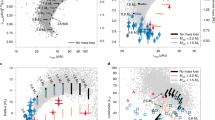Abstract
The chemical composition of stars with extremely low metal contents (taking 'metals' to mean all elements other than hydrogen and helium) provides us with information on the masses of the stars that produced the first metals. Such a direct connection is not possible, however, if the surface of the star has been polluted by enriched material, either dredged from the star's interior or transferred from a companion star. Here we argue that, in the case of HE0107–5240 (ref. 1), the most iron-poor star known, the oxygen abundance could be a discriminant: a ratio of [O/Fe] exceeding +3.5 would favour a pristine origin of metals, whereas an [O/Fe] ratio of less than +3 would favour the pollution hypothesis. Using this criterion, we suggest how the required information on oxygen abundance might be obtained.
Similar content being viewed by others
Main
HE0107–5240 shows carbon, nitrogen and sodium enhanced, respectively, by factors of 104, 102.3 and 10 relative to iron, whereas magnesium, which is usually more abundant in metal-poor stars, is present in almost the same amounts as iron; no single supernova (SNII) model seems to show this pattern2. Although several models may be worth considering, we evaluate two here: a pristine origin due to the combined enrichment of at least two SNIIs, or a pollution of the surface of the star after its formation.
If the metals are pristine, then HE0107–5240 must have formed from a cloud enriched by the ejecta of at least two zero-metallicity SNIIs of quite different initial masses. The first supernova, which was presumably rather massive, would have produced the light elements observed in HE0107–5240, but none of the heavier ones, because of an extensive fallback, up to the base of the helium shell. This would have prevented the ratios [C/N] and [Mg/C] from becoming too high. The second supernova, which was less massive, would have provided all of the elements heavier than and including magnesium.
In contrast, in the case of pollution enrichment, HE0107–5240 would be either a low-mass, zero-metallicity star that accreted matter enriched by the first generation of SNII, or a second-generation low-mass star of very low metallicity. The high [C,N,Na/Fe] ratios would be the result of subsequent enrichment of the surface of the star, due either to an internal process or to the accretion of matter synthesized by an asymptotic giant branch (AGB) star in a binary system.
One way to discriminate between pristine and pollution origins of C and N is to measure the abundance of oxygen. In the pristine case, the more massive supernova would provide a large amount of oxygen, leading to a high [O/Fe] (> +3.5), as can be derived from the yields of zero-metal massive stars2. In the pollution case, a lower [O/Fe] is expected (< +3.0), as implied by the yields of zero-metal, intermediate-mass stars3.
An upper limit of 0.1 pm (where 1 pm is 10−12 m) on the equivalent width of the [Oi] 630-nm line would provide a limit on oxygen, namely [O/H]< −2.3 or [O/Fe]< +3. With the Ultraviolet–Visual Echelle Spectrograph on the European Southern Observatory's Very Large Telescope, we estimate that such a limit could be achieved in about 30 h of exposure. The situation is slightly better for OH ultraviolet lines, for which we estimate that an upper limit of [O/Fe]< +2.0 could be derived even at moderate signal-to-noise ratios (>20), which should be achieved in about 4 h of exposure. At this signal-to-noise ratio, it is possible to discriminate between [O/Fe]< +3.0 and [O/Fe]> +3.5; however, lower oxygen abundances would be very difficult to measure, whatever the signal-to-noise ratio. As high-resolution spectra have already been obtained, including the ultraviolet region containing the OH lines, for a total of about 30 h of exposure (ESO/ST-ECF Science Archive), it may now be possible to carry out the test that we propose.
Among extremely metal-poor stars, oxygen has been observed only in the star CS 22949–037 (ref. 4), for which [O/Fe]= +2.0; all other known stars have oxygen features that are below the detection threshold. However, CS 29498–043 (ref. 5) has a very similar pattern of marked overabundance of the lighter elements; its oxygen abundance, which has not yet been measured, may prove to be strongly enhanced as well.
We note that the high observed [C/N] in HE0107–5240 is difficult to explain in terms of pollution, whether internal or from an AGB companion, because of the high abundance of primary nitrogen in both cases. We argue that a pristine origin is more likely, which implies that the [O/Fe] ratio is higher than in any other known metal-poor star.
References
Christlieb, N. et al. Nature 419, 904–906 (2002).
Chieffi, A. & Limongi, M. Astrophys. J. 577, 281–294 (2002).
Chieffi, A., Limongi, M., Domìnguez, I. & Straniero, O. in New Quests in Stellar Astrophysics: The Link Between Stars and Cosmology (eds Chavez, M. et al.) 47–54 (Kluwer Academic, Dordrecht, The Netherlands, 2002).
Depagne, E. et. al. Astron. Astrophys. 390, 187–198 (2002).
Aoki, W., Norris, J. E., Ryan, S. G., Beers, T. C. & Ando, H. Astrophys. J. 576, L141–L144 (2002).
Author information
Authors and Affiliations
Corresponding author
Rights and permissions
About this article
Cite this article
Bonifacio, P., Limongi, M. & Chieffi, A. How did the metals in a giant star originate?. Nature 422, 834 (2003). https://doi.org/10.1038/422834a
Issue Date:
DOI: https://doi.org/10.1038/422834a
This article is cited by
-
Telling the tale of the first stars
Nature (2003)
Comments
By submitting a comment you agree to abide by our Terms and Community Guidelines. If you find something abusive or that does not comply with our terms or guidelines please flag it as inappropriate.



